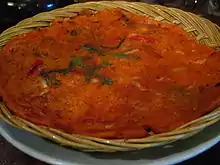Kimchi
Kimchi (/ˈkɪmtʃiː/; Korean: 김치, romanized: gimchi, IPA: [kim.tɕʰi]), a staple in Korean cuisine, is a traditional side dish of salted and fermented vegetables, such as napa cabbage and Korean radish, made with a widely varying selection of seasonings including gochugaru (chili powder), spring onions, garlic, ginger, and jeotgal (salted seafood), etc.[1][2] It is also used in a variety of soups.
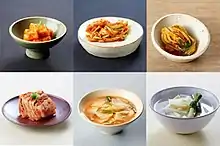 Various forms of contemporary kimchi | |
| Course | Banchan |
|---|---|
| Place of origin | Korea |
| Region or state | Korea |
| Associated national cuisine | |
| Main ingredients | Various vegetables including napa cabbage and Korean radish |
| Variations | Baechu-kimchi, baek-kimchi, dongchimi, kkakdugi, nabak-kimchi, pa-kimchi, yeolmu-kimchi, gat-kimchiseokbakji |
| Korean name | |
| Hangul | 김치 |
|---|---|
| Revised Romanization | gimchi |
| McCune–Reischauer | kimch'i |
| IPA | [kim.tɕʰi] |
There are hundreds of varieties of kimchi made with different vegetables as the main ingredients.[3][4] Traditionally, kimchi was stored in-ground in large earthenware to prevent the kimchi from being frozen during the winter months. It was the primary way of storing vegetables throughout the seasons. In the summer the in-ground storage kept the kimchi cool enough to slow down the fermentation process.[2] In contemporary times, kimchi refrigerators are more commonly used to store kimchi.
Etymology
Ji
The term ji (지), which has its origins in archaic Korean dihi (디히), has been used to refer to kimchi since ancient times.[5] The sound change can be roughly described as:[6]
- dihi (디히) > di (디) > ji (지)
The Middle Korean form dihi is found in several books from Joseon (1392–1897).[7][8] In Modern Korean, the word remains as the suffix -ji in the standard language (as in jjanji, seokbak-ji),[9][10] and as the suffix -ji as well as the noun ji in Gyeongsang and Jeolla dialects.[11] The unpalatalized form di is preserved in P'yŏngan dialect.[12]
Kimchi
Kimchi (김치) is the accepted word in both North and South Korean standard languages. Earlier forms of the word include timchɑi (팀ᄎᆡ), a Middle Korean transcription of the Sino-Korean word 沈菜 (literally "submerged vegetable"). Timchɑi appears in Sohak Eonhae,[13] the 16th century Korean rendition of the Chinese book, Xiaoxue.[14] Sound changes from Middle Korean to Modern Korean regarding the word can be described as:[15]
- timchɑi (팀ᄎᆡ; 沈菜) > dimchɑi (딤ᄎᆡ) > jimchɑi (짐ᄎᆡ) > jimchui (짐츼) > gimchi (김치)
The aspirated first consonant of timchae became unaspirated in dimchɑe, then underwent palatalization in jimchɑe. The word then became jimchui with the loss of the vowel ɑ (ㆍ) in Korean language, then Kimchi, with the depalatalized word-initial consonant. In Modern Korean, the hanja characters 沈菜 are pronounced chimchae (침채), and are not used to refer to kimchi, or anything else. The word Kimchi is not considered as a Sino-Korean word.[15] Older forms of the word are retained in many regional dialects: jimchae (Jeolla, Hamgyŏng dialects),[16] jimchi (Chungcheong, Gangwon, Gyeonggi, Gyeongsang, Hamgyŏng, Jeolla dialects),[17] and dimchi (P'yŏngan dialect).[18]
The English word "kimchi" perhaps originated from kimch'i, the McCune–Reischauer transcription of the Korean word Kimchi (김치).
History
Samguk Sagi, a historical record of the Three Kingdoms of Korea, also mentions the pickle jar used to ferment vegetables, which indicates that fermented vegetables were commonly eaten during this time.[19][20] During the Silla dynasty (57 BC – AD 935), kimchi became prevalent as Buddhism caught on throughout the nation and fostered a vegetarian lifestyle.[21]
The pickling of vegetables was an ideal method, prior to refrigerators, that helped to preserve the lifespan of foods. In Korea, kimchi was made during the winter by fermenting vegetables, and burying it in the ground in traditional brown ceramic pots called onggi. This labor further allowed a bonding among women within the family.[21] A poem on Korean radish written by Yi Gyubo, a 13th-century literatus, shows that radish kimchi was a commonplace in Goryeo (918–1392).[4][22][23]
Pickled radish slices make a good summer side-dish,
Radish preserved in salt is a winter side-dish from start to end.
The roots in the earth grow plumper every day,
Harvesting after the frost, a slice cut by a knife tastes like a pear.— Yi Gyubo, Donggukisanggukjip (translated by Michael J. Pettid, in Korean cuisine: An Illustrated History)
Kimchi has been a staple in Korean culture, but historical versions were not a spicy dish.[24] Early records of kimchi do not mention garlic or chili pepper.[25] Chili peppers, now a standard ingredient in kimchi, had been unknown in Korea until the early seventeenth century due to its being a New World crop. Chili peppers, originally native to the Americas, were introduced to East Asia by Portuguese traders.[25][26][27] The first mention of chili pepper is found in Jibong yuseol, an encyclopedia published in 1614.[19][28] Sallim gyeongje, a 17‒18th century book on farm management, wrote on kimchi with chili peppers.[19][29] However, it was not until the 19th century that the use of chili peppers in kimchi was widespread.[30] The recipes from early 19th century closely resemble today's kimchi.[31][32]
A 1766 book, Jeungbo sallim gyeongje, reports kimchi varieties made with myriad ingredients, including chonggak-kimchi (kimchi made with chonggak radish), oi-sobagi (with cucumber), seokbak-ji (with jogi-jeot), and dongchimi.[19][33] However, napa cabbage was introduced to Korea only at the end of 19th century,[30] and whole-cabbage kimchi similar to its current form is described in Siuijeonseo, a cookbook published around that time.[34]
Kimchi is a national dish of both North and South Korea. During South Korea's involvement in the Vietnam War its government requested American help to ensure that South Korean troops, reportedly "desperate" for the food, could obtain it in the field;[35] South Korean president Park Chung-hee told U.S. President Lyndon B. Johnson that kimchi was "vitally important to the morale of Korean troops". It was also sent to space on board Soyuz TMA-12 with South-Korean astronaut Yi So-yeon after a multimillion-dollar research effort to kill the bacteria and lessen the odor without affecting taste.[35] On 22 November 2017 a Google Doodle was used to "Celebrate Kimchi".[36]
Ingredients
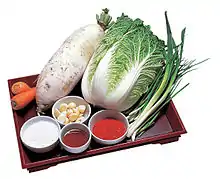
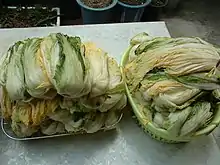

Kimchi varieties are determined by the main vegetable ingredients and the mix of seasoning used to flavor the kimchi.
Vegetables
There are many types of Kimchi dishes, and the most famous meal in this category is the cabbage Kimchi.[37] For many families, this pungent and often spicy meal is a source of pride and recalls the taste of a good home.[37] Cabbages (napa cabbages, bomdong, headed cabbages) and radishes (Korean radishes, ponytail radishes, gegeol radishes, yeolmu radishes) are the most commonly used kimchi vegetables.[1][2] Other kimchi vegetables include: aster, balloon flower roots, burdock roots, celery, chamnamul, cilantro, cress, crown daisy greens, cucumber, eggplant, garlic chives, garlic scapes, ginger, Korean angelica-tree shoots, Korean parsley, Korean wild chive, lotus roots, mustard greens, onions, perilla leaves, bamboo shoot, momordica charantia, pumpkins, radish greens, rapeseed leaves, scallions, soybean sprouts, spinach, sugar beets, sweet potato vines, and tomatoes.[38]
Seasonings
Brining salt (with a larger grain size compared to kitchen salt) is used mainly for initial salting of kimchi vegetables. Being minimally processed, it serves to help develop flavours in fermented foods.[39] Cabbage is usually salted twice when making spicy kimchi.
Commonly used seasonings include gochugaru (chili powder), scallions, garlic, ginger, and jeotgal (salted seafood)[1][2] Jeotgal can be replaced with raw seafood in colder Northern parts of the Korean peninsula.[40] If used, milder saeu-jeot (salted shrimp) or jogi-jeot (salted croaker) is preferred and the amount of jeotgal is also reduced in Northern and Central regions.[40] In Southern Korea, on the other hand, generous amount of stronger myeolchi-jeot (salted anchovies) and galchi-jeot (salted hairtail) is commonly used.[40] Raw seafood or daegu-agami-jeot (salted cod gills) are used in the East coast areas.[40]
Salt, scallions, garlic, fish sauce, and sugar are commonly added to flavour the kimchi.[41]
Microorganisms present in kimchi
The microorganisms present in kimchi include Bacillus mycoides, B. pseudomycoides, B. subtilis, Lactobacillus brevis, Lb. curvatus, Lb. kimchii, Lb. parabrevis, Lb. pentosus, Lb. plantarum, Lb. sakei, Lb. spicheri, Lactococcus carnosum, Lc. gelidum, Lc. lactis, Leuconostoc carnosum, Ln. citreum, Ln. gasicomitatum, Ln. gelidum, Ln. holzapfelii, Ln. inhae, Ln. kimchii, Ln. lactis, Ln. mesenteroides, Serratia marcescens, Weissella cibaria, W. confusa, W. kandleri, W. kimchii. W. koreensis, and W. soli.[42][43][44][45][46][47][48][49] Archaea and yeasts are also present in kimchi,[50] with the latter being responsible for undesirable white colonies that sometimes form in the product.[51]
These microorganisms are present due to the natural microflora provided by utilizing unsterilized food materials in the production of kimchi.[52][53] The step of salting the raw materials inhibits the pathogenic and putrefactive bacteria present in the microflora, allowing the lactic acid bacteria (LAB) to flourish and become the dominant microorganism.[52][54] These anaerobic microorganisms steadily increase in number during the middle stages of fermentation, and prefer to be kept at low temperatures of about 10℃, pH of 4.2-4, and remain in the presence of NaCl.[52] Since the raw cruciferous vegetables themselves are the source of LAB required for fermentation, no starter culture is required for the production of kimchi; rather, “spontaneous fermentation” occurs.[55] The total population of microorganisms present at the beginning of processing determine the outcome of fermentation, causing the final product to be highly variable in terms of quality and flavour.[52] Currently, there are no recommended approaches to control the microbial community during fermentation to predict the final outcome.[55]
By-products of microorganism metabolism
The LAB bacteria produce lactic acid, hydrogen peroxide, and carbon dioxide as by-products during metabolism. Lactic acid quickly lowers the pH, creating an acidic environment that is uninhabitable for most other microorganisms that survived salting.[53] This also modifies the flavour of sub-ingredients and can increase the nutritive value of the raw materials, as the microbial community in the fermentation process can synthesize B vitamins and hydrolyze cellulose in plant tissues to free nutrients that are normally indigestible by the human gastrointestinal tract.[53] Hydrogen peroxide is formed by the oxidation of reduced nicotinamide adenine dinucleotide (NADH) and provides an antibiotic to inhibit some undesirable microorganisms.[53] Carbon dioxide functions as a preservative, flushing out oxygen to create an anaerobic environment, as well as creating the desired carbonation in the final product.[53]
Varieties

Kimchi is one of the most important dishes in Korean cuisine. "Kimchi" is Korean terminology for fermented vegetables, and encompasses salt and seasoned vegetables.[37] Kimchi is a traditional Korean dish consisting of pickled vegetables, which is mainly served as a side dish with every meal, but also can be served as a main dish.[56] Kimchi is mainly recognized as a spicy fermented cabbage dish globally.[21]
Variations are not limited, as Koreans "can make kimchi out of anything edible; a concept which extends toward infinite possibilities..."[57] Variations of kimchi continue to grow, and the taste can vary depending on the region and season.[58] Conventionally, the secret of kimchi preparation was passed down by mothers to their daughters in a bid to make them suitable wives to their husbands.[59] However, with the current technological advancement and increase in social media use, many individuals worldwide can now access the recipe for kimchi preparation. It is highly nutritious and offers deeply-flavored and spicy meals favorable to many classes of people, and illustrates the Korean culture as well.[59]
Kimchi can be categorized by main ingredients, regions or seasons. Korea's northern and southern sections have a considerable temperature difference.[60] There are over 180 recognized varieties of kimchi.[61] The most common kimchi variations are
- Baechu-kimchi (배추김치) spicy napa cabbage kimchi, made from whole cabbage leaves
- Baechu-geotjeori (배추겉절이) unfermented napa cabbage kimchi
- Bossam-kimchi (보쌈김치) wrapped kimchi
- Baek-kimchi (백김치) white kimchi, made without chili pepper
- Dongchimi (동치미) a non-spicy watery kimchi
- Nabak-kimchi (나박김치) a mildly spicy watery kimchi
- Chonggak-kimchi (총각김치) cubed chonggak "ponytail" radish, a popular spicy kimchi
- Kkakdugi (깍두기) spicy cubed Korean radish strongly-scented kimchi containing fermented shrimp
- Oi-sobagi (오이소박이) cucumber kimchi that can be stuffed with seafood and chili paste, and is a popular choice during the spring and summer seasons
- Pa-kimchi (파김치) spicy green onion kimchi
- Yeolmu-kimchi (열무김치) is also a popular choice during the spring and summer, and is made with yeolmu radishes, and does not necessarily have to be fermented.
- Gat-kimchi (갓김치), made with Indian mustard
- Yangbaechu-kimchi (양배추 김치) spicy cabbage kimchi, made from "headed" cabbage leaves (as opposed to napa cabbage)
Kimchi from the northern parts of Korea tends to have less salt and red chili and usually does not include brined seafood for seasoning. Northern kimchi often has a watery consistency. Kimchi made in the southern parts of Korea, such as Jeolla-do and Gyeongsang-do, uses salt, chili peppers and myeolchijeot (멸치젓, brined anchovy allowed to ferment) or saeujeot (새우젓, brined shrimp allowed to ferment), myeolchiaekjeot (멸치액젓), kkanariaekjeot (까나리액젓), liquid anchovy jeot, similar to fish sauce used in Southeast Asia, but thicker.
Saeujeot (새우젓) or myeolchijeot is not added to the kimchi spice-seasoning mixture, but is simmered first to reduce odors, eliminate tannic flavor and fats, and then is mixed with a thickener made of rice or wheat starch (풀). This technique has been falling into disuse in the past 40 years.
Color
White kimchi are neither red in color nor spicy. It includes white napa cabbage kimchi and other varieties such as white radish kimchi (dongchimi). Watery white kimchi varieties are sometimes used as an ingredient in a number of dishes such as cold noodles in dongchimi brine (dongchimi-guksu).
Age
- Geotjeori (겉절이) are fresh, unfermented kimchi.
- Mugeun-ji (묵은지), also known as mugeun-kimchi (묵은김치), aged kimchi
Region
This regional classification dates back to 1960s and contains plenty of historical facts, but the current kimchi-making trends in Korea are generally different from those mentioned below.[60]
- Pyongan-do (North Korea, outside of Pyongyang) Non-traditional ingredients have been adapted in rural areas due to severe food shortages.
- Hamgyeong-do (Upper Northeast): Due to its proximity to the ocean, people in this particular region use fresh fish and oysters to season their kimchi.
- Hwanghae-do (Midwest): The taste of kimchi in Hwanghae-do is not bland but not extremely spicy. Most kimchi from this region has less color since red chili flakes are not used. The typical kimchi for Hwanghae-do is called hobakji (호박지). It is made with pumpkin (bundi).

- Gyeonggi-do (Lower Midwest of Hwanghae-do)
- Chungcheong-do (Between Gyeonggi-do and Jeolla-do): Instead of using fermented fish, people in the region rely on salt and fermentation to make savory kimchi. Chungcheong-do has the most varieties of kimchi.
- Gangwon-do (South Korea)/Kangwon-do (North Korea) (Mideast): In Gangwon-do, kimchi is stored for longer periods. Unlike other coastal regions in Korea, kimchi in this area does not contain much salted fish.
- Jeolla-do (Lower Southwest): Salted yellow corvina and salted butterfish are used in this region to create different seasonings for kimchi.
- Gyeongsang-do (Lower Southeast): This region's cuisine is saltier and spicier. The most common seasoning components include myeolchijeot (멸치젓) which produce a briny and savory flavor.
- Foreign countries: In some places of the world people sometimes make kimchi with western cabbage and many other alternative ingredients such as broccoli.[62][63]
Season
Different types of kimchi were traditionally made at different times of the year, based on when various vegetables were in season and also to take advantage of hot and cold seasons before the era of refrigeration. Although the advent of modern refrigeration — including kimchi refrigerators specifically designed with precise controls to keep different varieties of kimchi at optimal temperatures at various stages of fermentation — has made this seasonality unnecessary, Koreans continue to consume kimchi according to traditional seasonal preferences.[64]
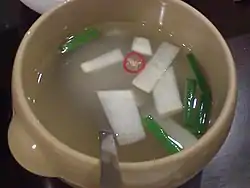
- Spring
After a long period of consuming gimjang kimchi (김장김치) during the winter, fresh potherbs and vegetables were used to make kimchi. These kinds of kimchi were not fermented or even stored for long periods of time but were consumed fresh.
- Summer

Yeolmu radishes and cucumbers are summer vegetables made into kimchi, yeolmu-kimchi (열무김치) which is eaten in several bites. Brined fish or shellfish can be added, and freshly ground dried chili peppers are often used.
- Autumn
Baechu kimchi is prepared by inserting blended stuffing materials, called sok (literally inside), between layers of salted leaves of uncut, whole Napa cabbage. The ingredients of sok (속) can vary, depending on the regions and weather conditions. Generally, baechu kimchi used to have a strong salty flavor until the late 1960s, before which a large amount of myeolchijeot or saeujeot had been used.
Gogumasoon Kimchi is made from sweet potato stems.
- Winter
Traditionally, the greatest varieties of kimchi were available during the winter. In preparation for the long winter months, many types of kimjang kimchi (김장 김치) were prepared in early winter and stored in the ground in large kimchi pots. Today, many city residents use modern kimchi refrigerators offering precise temperature controls to store kimjang kimchi. November and December are traditionally when people begin to make kimchi; women often gather together in each other's homes to help with winter kimchi preparations.[65] "Baechu kimchi" is made with salted baechu filled with thin strips of radish, parsley, pine nuts, pears, chestnuts, shredded red pepper, manna lichen (Korean: 석이 버섯; RR: seogi beoseot), garlic, and ginger.
Korean preference
A 2004 book about vegetable preservation said that the preference of kimchi preparation in Korean households from the most prepared type of kimchi to less prepared types of kimchi was: baechu kimchi, being the most prepared type of kimchi, then kaktugi, then dongchimi and then chonggak kimchi. The book said that baechu kimchi comprises more than seventy percent of marketed kimchi and radish kimchi comprises about twenty percent of marketed kimchi.[66]
Trade
South Korea spent around $129 million in 2017 to purchase 275,000 metric tons foreign kimchi, more than 11 times the amount it exported, according to data released by the Korea Customs Service in 2017.[67] South Korea consumes 1.85 million metric tons of kimchi annually, or 36.1 kg per person.[68] It imports a significant fraction of that, mostly from China, and runs a $47.3 million kimchi trade deficit.[69]
Nutrition and health
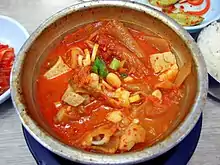
Kimchi is made of various vegetables and contains a high concentration of dietary fiber,[70] while being low in calories. The vegetables used in kimchi also contribute to intake of vitamin A, thiamine (B1), riboflavin (B2), calcium, and iron.[71][72]
| Nutrients | per 100 g | Nutrients | per 100 g |
|---|---|---|---|
| Food energy | 32 kcal | Moisture | 88.4 g |
| Crude protein | 2.0 g | Crude lipid | 0.6 g |
| Total sugar | 1.3 g | Crude fiber | 1.2 g |
| Crude ash | 0.5 g | Calcium | 45 mg |
| Phosphorus | 28 mg | Vitamin A | 492 IU |
| Vitamin B1 | 0.03 mg | Vitamin B2 | 0.06 mg |
| Niacin | 2.1 mg | Vitamin C | 21 mg |
| Fermentation Time (Week) | Carotene (μg%) | Vitamin B1 (μg%) | Vitamin B2 (μg%) | Vitamin B12 (μg%) | Niacin (μg%) | Vitamin C (mg%) | |
|---|---|---|---|---|---|---|---|
| 49.5a | 41.7 | 66 | 0.17 | 740 | 28.9 | ||
| 44.0 (35.4)b | 41.6 (40.1) | 47 (54) | 0.09 (0.09) | 781 (747) | 25.0 (25.3) | ||
| 32.0 (30.4) | 70.9 (61.9) | 110 (99) | 0.19 (0.20) | 928 (861) | 27.8 (28.5) | ||
| 26.6 (26.9) | 79.1 (87.5) | 230 (157) | 0.25 (0.33) | 901 (792) | 23.6 (22.3) | ||
| 21.0 (25.3) | 62.7 (70.8) | 35 (95) | 0.20 (0.26) | 591 (525) | 16.7 (16.0) | ||
| 24.2 (20.1) | 53.3 (49.1) | 40 (37) | 0.10 (0.16) | 11.16 (11.0) | |||
| aNaturally fermented baechu kimchi bAverage levels of four kimchis; common kimchi +3 different starter inoculated kimchis | |||||||
| Components | Baechu Kimchi | Kaktugi | Gat Kimchi | Pa Kimchi | Baek Kimchi | Yeolmoo Kimchi | Dongchimi | Nabak Kimchi | |
|---|---|---|---|---|---|---|---|---|---|
| Calorie (kcal) | 18 | 33 | 41 | 52 | 8 | 38 | 11 | 9 | |
| Moisture (%) | 90.8 | 88.4 | 83.2 | 80.7 | 95.7 | 84.5 | 94.2 | 95.1 | |
| Crude protein (g) | 2 | 1.6 | 3.9 | 3.4 | 0.7 | 3.1 | 0.7 | 0.8 | |
| Crude lipid (g) | 0.5 | 0.3 | 0.9 | 0.8 | 0.1 | 0.6 | 0.1 | 0.1 | |
| Crude ash (g) | 2.8 | 2.3 | 3.5 | 3.3 | 1.5 | 3.2 | 2 | 1.5 | |
| Carbohydrate (g) | 3.9 | 7.4 | 8.5 | 11.8 | 2 | 8.6 | 3 | 2.5 | |
| Dietary fiber (g) | 3 | 2.8 | 4 | 5.1 | 1.4 | 3.3 | 0.8 | 1.5 | |
| Vitamins | Baechu Kimchi | Kaktugi | Gat Kimchi | Pa Kimchi | Baek Kimchi | Yeolmoo Kimchi | Dongchimi | Nabak Kimchi | |
|---|---|---|---|---|---|---|---|---|---|
| Vitamin A (RE) | 48 | 38 | 390 | 352 | 9 | 595 | 15 | 77 | |
| Vitamin A (β-Carotene) (μg) | 290 | 226 | 2342 | 2109 | 53 | 3573 | 88 | 460 | |
| Vitamin B1 (mg) | 0.06 | 0.14 | 0.15 | 0.14 | 0.03 | 0.15 | 0.02 | 0.03 | |
| Vitamin B2 (mg) | 0.06 | 0.05 | 0.14 | 0.14 | 0.02 | 0.29 | 0.02 | 0.06 | |
| Niacin (mg) | 0.8 | 0.5 | 1.3 | 0.9 | 0.3 | 0.6 | 0.2 | 0.5 | |
| Vitamin C (mg) | 14 | 19 | 48 | 19 | 10 | 28 | 9 | 10 | |
| Vitamin B6 (mg) | 0.19 | 0.13 | |||||||
| Folic acid (μg) | 43.3 | 58.9 | 74.8 | ||||||
| Vitamin E (mg) | 0.7 | 0.2 | 1.3 | ||||||
| Not detected: vitamin A (retinol), pantothenic acid, vitamin B12, vitamin K | |||||||||
A 2003 article said that South Koreans consume 18kg (40lbs) of kimchi per person annually.[76] Many credit the Korean Miracle in part to eating the dish.[35] A 2015 book cited a 2011 source that said that adult Koreans eat from 50 grams (0.11 lb) to 200 grams (0.44 lb) of kimchi a day.[75] During the 2003 SARS outbreak in Asia, many people believed that kimchi could protect against infection. While there was no scientific evidence to support this belief, kimchi sales rose by 40%.[77]
Dishes usually served with kimchi
Kimchi is known to be a traditional side dish as it is almost always served along with other side dishes in most Korean family households and restaurants. Kimchi can be eaten alone or with white or brown rice, but it is also included in recipes of other traditional dishes, including porridges, soups, and rice cakes. Kimchi is also the basis for many derivative dishes such as kimchi stew (김치찌개; gimchijjigae), kimchi pancake (김치전; gimchibuchimgae), kimchi soup (김칫국; gimchiguk), and kimchi fried rice (김치볶음밥; gimchibokkeumbap).
Army base stew (부대찌개; Budae-jjigae) is a popular dish made with spam, sausage, and kimchi. It originated after the Korean war with ingredients that would be scrounged from the army.
Procedure
The first step in the making of any kimchi is to slice the cabbage or daikon into smaller, uniform pieces to increase the surface area.[78] The pieces are then coated with salt as a preservative method, as this draws out the water to lower the free water activity. This inhibits the growth of undesirable microorganisms by limiting the water available for them to utilize for growth and metabolism.[78] The salting stage can use 5 to 7% salinity for 12 hours, or 15% for 3 to 7 hours.[53] The excess water is then drained away, and seasoning ingredients are added.[78] The sugar that is sometimes added also acts to bind free water that still remains, further reducing free water activity. Finally, the brined vegetables are placed into an airtight canning jars and left to sit for 24 to 48 hours at room temperature.[78] The ideal salt concentration during the fermentation process is about 3%.[53] Since the fermentation process results in the production of carbon dioxide, the jar should be “burped” daily to release the gas.[78] The more fermentation that occurs, the more carbon dioxide will be incorporated, which results in a very carbonaded-drink-like affect.
Food regulations
The Canadian Food Inspection Agency has regulations for the commercial production of kimchi. The final product should have a pH ranging from 4.2 to 4.5.[79] Any low-acidity ingredients with a pH above 4.6, including white daikon and napa cabbage, should not be left under conditions that enable the growth of undesirable microorganisms and require a written illustration of the procedure designed to ensure this available if requested.[79] This procedural design should include steps that maintain sterility of the equipment and products used, and the details of all sterilization processes.[79]
Recent history
1996 kimchi standard dispute with Japan
In 1996, Korea protested against Japanese commercial production of kimchi arguing that the Japanese-produced product (kimuchi, キムチ) was different from kimchi. In particular, Japanese kimuchi was not fermented and more similar to asazuke. Korea lobbied for an international standard from the Codex Alimentarius, an organization associated with the World Health Organization that defines voluntary standards for food preparation for international trade purposes.[76][80] In 2001, the Codex Alimentarius published a voluntary standard defining kimchi as "a fermented food that uses salted napa cabbages as its main ingredient mixed with seasonings, and goes through a lactic acid production process at a low temperature", but which neither specified a minimum amount of fermentation nor forbade the use of any additives.[81]
1998 to 2007 motherland tours
South Korea developed programs for adult Korean adoptees to return to South Korea and learn about what it means to be Korean. One of these programs was learning how to make kimchi.[82]
2010 kimchi ingredient price crisis
Due to heavy rainfall shortening the harvesting time for cabbage and other main ingredients for kimchi in 2010, the price of kimchi ingredients and kimchi itself rose greatly. Korean and international newspapers described the rise in prices as a national crisis.[83] Some restaurants stopped offering kimchi as a free side dish, which The New York Times compared to an American hamburger restaurant no longer offering free ketchup.[65] In response to the kimchi price crisis, the South Korean government announced the temporary reduction of tariffs on imported cabbage to coincide with the Kimjang season.[84]
2012 effective ban of Korean kimchi exports to China
Since 2012, the Chinese government has effectively banned Korean kimchi exports to China through government regulations. Ignoring the standards of Kimchi outlined by the Codex Alimentarius, China defined kimchi as a derivative of one of its own cuisines, called pao cai.[85] However, due to significantly different preparation techniques from pao cai, kimchi has significantly more lactic acid bacteria through its fermentation process, which exceeds China's regulations.[86] Since 2012, commercial exports of Korean kimchi to China has reached zero, the only minor amounts of exports accounting for Korean kimchi are exhibition events held in China.[85]
Intangible Cultural Heritage of Humanity
Kimchi-related items have been inscribed on UNESCO's Representative List of the Intangible Cultural Heritage of Humanity by both South and North Korea. This makes kimchi the second intangible heritage that was submitted by two countries, the other one being the folk song "Arirang" which was also submitted by both the Koreas.[87]
Submitted by South Korea (inscribed 2013)
Kimjang, the tradition of making and sharing of kimchi that usually takes place in late autumn, was added to the list as "Kimjang, making and sharing kimchi in the Republic of Korea". The practice of Kimjang reaffirms Korean identity and strengthens family cooperation. Kimjang is also an important reminder for many Koreans that human communities need to live in harmony with nature.[88]
Submitted by North Korea (inscribed 2015)
North Korean kimchi-making was inscribed on the list in December 2015[87] as "Tradition of kimchi-making in the Democratic People's Republic of Korea".[89] North Korean kimchi tends to be less spicy and red than South Korean kimchi.[90] Seafood is used less often and less salt is added. Additional sugar is used to help with fermentation in the cold climate.[91]
Boycott in China
A 2017 article in The New York Times said that anti-Korean sentiment in China has risen after South Korea's acceptance of the deployment of THAAD in South Korea, government-run Chinese news media has encouraged the boycott of South Korean goods, and Chinese nationalists have vowed to not eat kimchi.[92] The move was criticized by other Chinese nationalists, who noted that China officially considered Koreans an integral ethnic group in the multinational state, and that Kimchi is also indigenous to the Koreans in the Yanbian Korean Autonomous Prefecture.[93][94]Chinese nationalists have also criticized Korean kimchi, by calling them "merely pickles"[95] whereas Chinese kimchi pao cai's literal meaning is "pickled vegetable"[96]
2020 kimchi origin dispute with China
In November 2020, the International Organisation for Standardisation (ISO) posted new regulations for the making of pao cai.[97] [98] Some press, including the Korea Times and the BBC, reported a claim made by the Chinese state-run Global Times that said the pass of these new regulations set "an international standard for the kimchi industry led by China."[99][100] This claim has sparked strong responses from South Korean media, which subsequently prompted anger on the Internet.[101] [102][103][104][105][106][107][108][109] Angry reactions were caused when a South Korean mukbang star "Hamzy", with 5.6 million subscribers on YouTube, lost her contract with Shanghai-based Chinese agency Suxian Advertising, after liking comments suggesting that kimchi is of Korean origin.[110][111] Other incidents that sparked heated reactions include Li Ziqi, a popular Chinese web figure with 14.3 million subscribers on YouTube, sharing a video in which she makes kimchi with hashtags "ChineseCuisine" and "ChineseFood",[110][111] as well as the PRC ambassador to the United Nations, Zhang Jun, sharing a picture of himself holding kimchi on Twitter.[112]
Gallery
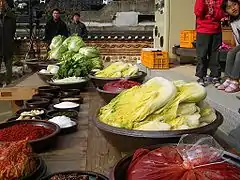 Preparation for making kimchi
Preparation for making kimchi Seokryu kimchi named after its pomegranate-like shape
Seokryu kimchi named after its pomegranate-like shape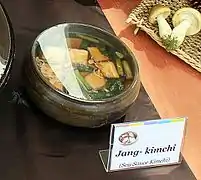 Jang kimchi, pickled with soy sauce
Jang kimchi, pickled with soy sauce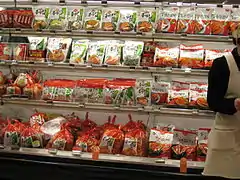 Displayed manufactured kimchi
Displayed manufactured kimchi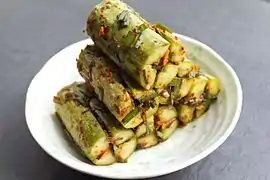 Oi-sobagi (cucumber kimchi)
Oi-sobagi (cucumber kimchi)
See also
- Foods containing tyramine
- Jangajji – Type of Korean non-fermented pickled vegetable side dish
- Jeotgal – Korean salted seafood category
- Kimchi burger
- Korean radish
- Korean brining salt
- Morkovcha – A spicy marinated carrot salad – a variety of kimchi made of carrots by Koryo-saram
- List of cabbage dishes – Wikipedia list article
- List of English words of Korean origin – Wikipedia list article
- List of pickled foods – List of links to Wikipedia articles on pickled foods
- Pao cai – A type of pickle in Chinese, and particularly Sichuan cuisine.
- Sauerkraut – Finely sliced and fermented cabbage
- Torshi, also known as Tursu – The pickled vegetables of the cuisines of many Balkan and Middle East countries
References
- "Kimchi". Encyclopædia Britannica. 1 October 2008. Retrieved 23 March 2017.
- Chin, Mei (14 October 2009). "The Art of Kimchi". Saveur. Retrieved 9 August 2010.
- McAninch, David (14 October 2009). "A World of Kimchi". Saveur. Retrieved 13 September 2014.
- Pettid, Michael J. (2008). Korean Cuisine: An Illustrated History. London: Reaktion Books. pp. 47–51. ISBN 978-1-86189-348-2.
- 이, 태영 (23 May 2006). "[고장말탐험] '김치'와 '지'". The Hankyoreh (in Korean). Retrieved 27 March 2017.
- Hong, Giok (2016). "Study on the Lexicon Related to Gimchi -Based on Survey of Ethnic Living Words in 2008-". The Korean Association for Dialectology (24): 61–99. doi:10.19069/kordialect.2016.24.061.
- Uichim; Jo, Wi; Yu, Yungyeom; Yu, Hyubok; et al., eds. (1632) [1481]. Bullyu Du Gongbu si Eonhae 분류두공부시언해(分類杜工部詩諺解) [Poems by Du Fu, Korean Translation]. 3 (reprint ed.). Joseon Korea.
長安앳 겨 디히 싀오 고
- Garye Eonhae 가례언해(家禮諺解) [Vernacular Edition of the Chia-li]. 10. Translated by Sin, Sik. Joseon Korea. 1632.
豆 디히 젓 담 목긔라
(from the original Jiālǐ 家禮 by Zhu Xi) - "jjanji" 짠지. Standard Korean Language Dictionary (in Korean). National Institute of Korean Language. Retrieved 27 March 2017.
- "seokbak-ji" 섞박지. Standard Korean Language Dictionary (in Korean). National Institute of Korean Language. Retrieved 27 March 2017.
- "ji" 지. Standard Korean Language Dictionary (in Korean). National Institute of Korean Language. Retrieved 27 March 2017.
- "seobeok-di" 서벅디. Standard Korean Language Dictionary (in Korean). National Institute of Korean Language. Retrieved 27 March 2017.
- Jeong, Gu; et al. (1586). Sohak Eonhae 소학언해(小學諺解) [Vernacular Rendition of the Elementary Learning] (in Korean). Joseon Korea – via Wikisource.
- Zhū, Xǐ; Liú, Qīngzhī. Xiǎoxué 小學 [Elementary Learning] (in Chinese). Song China – via Wikisource.
- "Kimchi" 김치 [kimchi]. Standard Korean Language Dictionary (in Korean). National Institute of Korean Language. Retrieved 24 March 2017.
- "jimchae" 짐채. Standard Korean Language Dictionary (in Korean). National Institute of Korean Language. Retrieved 27 March 2017.
- "jimchi" 짐치. Standard Korean Language Dictionary (in Korean). National Institute of Korean Language. Retrieved 27 March 2017.
- "dimchi" 딤치. Standard Korean Language Dictionary (in Korean). National Institute of Korean Language. Retrieved 27 March 2017.
- Hui, Y. H.; Ghazala, Sue; Graham, Dee M.; Murrell, K. D.; Nip, Wai-Kit, eds. (2004). Handbook of Vegetable Preservation and Processing. New York: Marcel Dekker. pp. 190–191. ISBN 978-0824743017.
- Busik, Gim (1145). Samguk Sagi 삼국사기(三國史記) [History of the Three Kingdoms] (in Korean). Goryeo Korea – via Wikisource.
- Logarta, Margie T. (September 2013). "In A Pickle". Business Traveller (Asia-Pacific Edition): 70–73.
- Yi, Gyubo (1241). "Gapoyugyeong" 가포육영(家圃六詠). DonggukIsanggukjip 동국이상국집(東國李相國集) [Collected works of Minister Yi of the Eastern Country] (in Literary Chinese). Goryeo Korea – via DB of Korean classics by ITKC.
- Breidt, Fred; McFeeters, Roger F.; Pérez-Díaz, Ilenys; Lee, Cherl-Ho (2013). "Fermented Vegetables" (PDF). In Doyle, Michael P.; Buchanan, Robert L. (eds.). Food Microbiology: Fundamentals and Frontiers (4th ed.). Washington, D.C.: American Society for Microbiology. p. 841. doi:10.1128/9781555818463.ch33. ISBN 9781555816261.
- Kimchi. (2016). Funk & Wagnalls New World Encyclopedia, 1p. 1.
- Guide to Korean Culture: Korea's cultural heritage (2015 ed.). Seoul: Korean Culture and Information Service, Ministry of Culture, Sports and Tourism. 2015 [1995]. pp. 131–133. ISBN 9788973755714.
- Park, Jae Bok (Spring 1999). "Red Pepper and Kichi in Korea" (PDF). Chile Pepper Institute Newsletter. 8 (1). p. 3. Retrieved 20 March 2017.
- Marianski, Stanley; Marianski, Adam (2012). Sauerkraut, Kimchi, Pickles & Relishes. Seminole, FL: Bookmagic. p. 45. ISBN 9780983697329.
- Yi, Sugwang. Jibong yuseol 지봉유설(芝峯類說) [Topical Discourses of Jibong] (in Korean). Joseon Korea – via Wikisource.
- Hong, Manseon. Sallim gyeongje 산림경제(山林經濟) [Farm Management] (in Literary Chinese). Joseon Korea. Archived from the original on 28 March 2017. Retrieved 17 February 2020 – via DB of Korean classics by ITKC.
- Cho, Hong Sik (2006). "Food and Nationalism: Kimchi and Korean National Identity". The Korean Journal of International Studies. 4 (1): 207–229. doi:10.14731/kjis.2006.12.46.5.207.
- Jeong, Hakyu. "Siwol" 시월(十月) [Tenth month]. Nongga wollyeongga 농가월령가(農家月令歌) [The Songs of Monthly Events of Farm Families].
- Hong, Seokmo. Dongguksesigi 동국세시기(東國歲時記) [A Record of the Seasonal Customs of the Eastern Kingdom]. Joseon Korea.
- Yu, Jungrim; Hong, Manseon (1766). Jeungbo sallim gyeongje 증보산림경제(增補山林經濟) [Revised and Augmented Farm Management]. Joseon Korea.
- Unknown (1919) [late 19th century]. Siuijeonseo (in Korean). Manuscript by Sim Hwanjin. Sangju, Korea. Lay summary – Korean Food Foundation.
- Sang-hun, Choe (24 February 2008). "Starship Kimchi: A Bold Taste Goes Where It Has Never Gone Before". The New York Times. Retrieved 27 August 2012.
- https://www.google.com/doodles/celebrating-kimchi?doodle=33821060
- Jang, Dai Ja; Lee, Ae Ja; Kang, Soon-A; Lee, Seung Min; Kwon, Dae Young (2016). "Does siwonhan-mat represent delicious in Korean foods?". Journal of Ethnic Foods. 3 (2): 159–162. doi:10.1016/j.jef.2016.06.002.
- "Kimchi, sikhae" 김치, 식해. Ch'osŏn Ryori (in Korean). Korean Association of Cooks. Retrieved 10 April 2017.
- Parks, Cara (16 December 2014). "Shaking Up Salt". Modern Farmer. Retrieved 10 April 2017.
- "kimchi" 김치. Doopedia. Doosan Corporation. Retrieved 10 April 2017.
- "Understanding and Making Kimchi" (PDF). Farm to Table. Colorado State University.
- Paramithiotis, Spiros; Papoutsis, George; Drosinos, Eleftherios H. (2017). Paramithiotis, Spiros (ed.). Lactic Acid Fermentation of Fruits and Vegetables. Boca Raton, FL: CRC Press. p. 5. ISBN 978-1-4987-2690-0.
- Lee, Jung-Sook; Heo, Gun-Young; Lee, Jun Won; Oh, Yun-Jung; Park, Jeong A.; Park, Yong-Ha; Pyun, Yu-Ryang; Ahn, Jong Seog (2005). "Analysis of kimchi microflora using denaturing gradient gel electrophoresis". International Journal of Food Microbiology. 102 (2): 143–150. doi:10.1016/j.ijfoodmicro.2004.12.010. PMID 15992614.
- Cho, Jinhee; Lee, Dongyun; Yang, Changnam; Jeon, Jongin; Kim, Jeongho; Han, Hongui (2006). "Microbial population dynamics of kimchi, a fermented cabbage product". FEMS Microbiology Letters. 257 (2): 262–267. doi:10.1111/j.1574-6968.2006.00186.x. PMID 16553862.
- Chang, H.; Kim, K.; Nam, Y.; Roh, S.; Kim, M.; Jeon, C.; Oh, H.; Bae, J. (2008). "Analysis of yeast and archaeal population dynamics in kimchi using denaturing gradient gel electrophoresis". International Journal of Food Microbiology. 126 (1–2): 159–166. doi:10.1016/j.ijfoodmicro.2008.05.013. PMID 18562030.
- Jung, Ji Young; Lee, Se Hee; Jin, Hyun Mi; Hahn, Yoonsoo; Madsen, Eugene L.; Jeon, Che Ok (2013). "Metatranscriptomic analysis of lactic acid bacterial gene expression during kimchi fermentation". International Journal of Food Microbiology. 163 (2–3): 171–179. doi:10.1016/j.ijfoodmicro.2013.02.022. PMID 23558201.
- Jeong, Sang Hyeon; Lee, Se Hee; Jung, Ji Young; Choi, Eun Jin; Jeon, Che Ok (2013). "Microbial Succession and Metabolite Changes during Long-Term Storage of Kimchi". Journal of Food Science. 78 (5): M763–M769. doi:10.1111/1750-3841.12095. PMID 23550842.
- Jeong, Sang Hyeon; Jung, Ji Young; Lee, Se Hee; Jin, Hyun Mi; Jeon, Che Ok (2013). "Microbial succession and metabolite changes during fermentation of dongchimi, traditional Korean watery kimchi". International Journal of Food Microbiology. 164 (1): 46–53. doi:10.1016/j.ijfoodmicro.2013.03.016. PMID 23587713.
- Hong, Yeun; Yang, H. S.; Chang, H. C.; Kim, H. Y. (2013). "Comparison of Bacterial Community Changes in Fermenting Kimchi at Two Different Temperatures Using a Denaturing Gradient Gel Electrophoresis Analysis" (PDF). Journal of Microbiology and Biotechnology. 23 (1): 76–84. doi:10.4014/jmb.1210.10002. PMID 23314371. S2CID 13462137.
- Chang, HW; Kim, KH; Nam, YD; Roh, SW; Kim, MS; Jeon, CO; Oh, HM; Bae, JW (15 August 2008). "Analysis of yeast and archaeal population dynamics in kimchi using denaturing gradient gel electrophoresis". International Journal of Food Microbiology. 126 (1–2): 159–66. doi:10.1016/j.ijfoodmicro.2008.05.013. PMID 18562030.
- Kim, JY; Kim, J; Cha, IT; Jung, MY; Song, HS; Kim, YB; Lee, C; Kang, SY; Bae, JW; Choi, YE; Kim, TW; Roh, SW (January 2019). "Community structures and genomic features of undesirable white colony-forming yeasts on fermented vegetables". Journal of Microbiology (Seoul, Korea). 57 (1): 30–37. doi:10.1007/s12275-019-8487-y. PMID 30392155. S2CID 53219410.
- Lee, Mo-Eun; Jang, Ja-Young; Lee, Jong-Hee; Park, Hae-Woong; Choi, Hak-Jong; Kim, Tae-Woon (28 May 2015). "Starter Cultures for Kimchi Fermentation". Journal of Microbiology and Biotechnology. 25 (5): 559–568. doi:10.4014/jmb.1501.01019. ISSN 1017-7825. PMID 25674806.
- Foods, National Research Council (US) Panel on the Applications of Biotechnology to Traditional Fermented (1992). Lactic Acid Fermentations. National Academies Press (US).
- Park, Kun-Young; Jeong, Ji-Kang; Lee, Young-Eun; Daily, James W. (January 2014). "Health Benefits of Kimchi (Korean Fermented Vegetables) as a Probiotic Food". Journal of Medicinal Food. 17 (1): 6–20. doi:10.1089/jmf.2013.3083. ISSN 1096-620X. PMID 24456350.
- Jung, Ji Young; Lee, Se Hee; Kim, Jeong Myeong; Park, Moon Su; Bae, Jin-Woo; Hahn, Yoonsoo; Madsen, Eugene L.; Jeon, Che Ok (1 April 2011). "Metagenomic Analysis of Kimchi, a Traditional Korean Fermented Food". Applied and Environmental Microbiology. 77 (7): 2264–2274. doi:10.1128/AEM.02157-10. ISSN 0099-2240. PMC 3067442. PMID 21317261.
- Korean Tourism Organization. (2015). Kimchi.
- di Schino, June (2011). "Kimchi: Ferment at the Heart of Korean Cuisine, from Local Identity to Global Consumption". In Saberi, Helen (ed.). Cured, Smoked, and Fermented: Proceedings of the Oxford Symposium on Food and Cookery 2010. Devon, UK: Prospect Books. p. 82. ISBN 978-1-903018-85-9.
- Kimchi. (2016). Funk & Wagnall's New World Encyclopedia, 1p. 1.
- Chung, Hae-Kyung; Shin, Dayeon; Chung, Kyung Rhan; Choi, Soe Yeon; Woo, Nariyah (2017). "Recovering the royal cuisine in Chosun Dynasty and its esthetics". Journal of Ethnic Foods. 4 (4): 242–253. doi:10.1016/j.jef.2017.12.001.
- "Kimchi." Yahoo Korean Encyclopedia Archived 24 January 2009 at the Wayback Machine
- "Kimchi". english.visitkorea.or.kr. Retrieved 1 April 2015.
- "North Texas Traditional Living" (PDF). Making Kimchi. Retrieved 14 February 2011.
- "TreeLight". Ultimate Kimchi. Archived from the original on 24 December 2010. Retrieved 14 February 2011.
- "High-tech kimchi refrigerators keep Korea's favorite food crisp". Hong Kong Trade Development Council. 14 March 2002. Retrieved 14 February 2008.
- McDonald, Mark (14 October 2010). "Rising Cost of Kimchi Alarms Koreans". The New York Times. Retrieved 16 October 2010.
- Hui et al. (2004). Handbook of Vegetable Preservation and Processing. New York: Marcel Dekker. Pages 190 & 191. Retrieved 23 March 2017, from link.
- Huang, Echo (19 January 2018). "The kimchi you eat outside of Korea is probably made in China". Quartz. Retrieved 19 January 2018.
- "Half of kimchi served at South Korean restaurants from China: Institute". The Jakarta Post. 6 October 2017. Retrieved 10 May 2020.
- Huang, Echo (19 January 2018). "The kimchi you eat outside of Korea is probably made in China". Quartz. Retrieved 19 January 2018.
- "Kimchi by Nancy Berkoff, RD, EdD, CCE". Archived from the original on 19 October 2014. Retrieved 13 September 2014.
- "Food in Korea". Asianinfo.com. Retrieved 30 January 2007.
- "Kimchi". Tour2korea.com. Retrieved 30 January 2007.
- from Korea Food Research Institute
- Hui, Y.H. (2005). Handbook of Food and Beverage Fermentation Technology. Taylor & Francis. Pages 740, 741 & 751. Retrieved 21 March 2017, from link.
- Tamang, J.P. (2015). Health Benefits of Fermented Foods and Beverages. CRC Press. Taylor & Francis Group. Pages 344, 350 & 351. Retrieved 21 March 2017, from link.
- Magnier, Mark (17 June 2003). "In an Age of SARS, Koreans Tout Kimchi Cure". Los Angeles Times. Retrieved 7 May 2010.
- "Korean Dish 'May Cure Bird Flu'". BBC News. 14 March 2005. Retrieved 4 April 2010.
- "Understanding and Making Kimchi" (PDF). Colorado Farm to Table Food Safety.
- "Chapter 5 - Process Products". Processed Products Establishment Inspection Manual. Canadian Food Inspection Agency. 30 August 2012.
- Sims, Calvin (February 2000) "Cabbage Is Cabbage? Not to Kimchi Lovers; Koreans Take Issue with a Rendition of Their National Dish Made in Japan". The New York Times.
- "Codex standard for kimchi" (PDF). The Codex Alimentarius Commission.
- In a video that was published to YouTube on 29 July 2013, Eleana J. Kim who is Assistant Professor of Anthropology as the University of Rochester talked about the international adoption of South Korean children. Kim's name and title appear at the 35:11 mark of the video. From the 26:56 mark of the video to the 28:09 mark of the video, Kim said, "Another aspect of the Korean adoptee experience that I explore in my book is their relationship to South Korea, and the South Korean state, and, uh, one of the things that the South Korean government, um, was, in a way, uh, um, compelled, to do, in the late nineteen nineties was to, recognize, adoptees, overseas adoptees, as Koreans, in some way. So, um, by nineteen ninety eight, adult Korean adoptees, who were living in Korea, petitioned the South Korean state to recognize them as overseas Koreans, Hanguggye dongpo, so that meant that they would be, uh, eligible for a special visa status, that would allow them to return to South Korea for extended periods of time, and, in line with this, this is an image from the overseas Korean foundation, uh, summer cultural program for overseas adoptees, and so, they developed these programs to help adult adoptees return to Korea and learn something about what it means to be Korean, so these programs are typically focused on traditional Korean culture, um, you know, adoptees dressing up in hanbok and learning how to make kimchi, um, such as these images here."
- "Of cabbages and Kims". The Economist. ISSN 0013-0613. Retrieved 28 June 2016.
- "South Korea's Kimchi Crisis". The Economist. 7 October 2010.
- "對중국 수출 '0'... 한국 김치가 운다". seoul.co.kr.
- "수입만 하고 수출 못하는 韓·中 '김치무역' 바꿀 것". Hankyung.com. 15 January 2014. Archived from the original on 24 September 2015.
- "UNESCO Adds N. Korea's Kimchi-Making to Cultural Heritage List". KBS. 3 December 2015. Retrieved 3 December 2015.
- "2003 Convention". UNESCO - Intangible Heritage Section.
- "Tradition of kimchi-making in the Democratic People's Republic of Korea". Culture Sector - UNESCO. Retrieved 3 December 2015.
- North Koreans Want UNESCO Recognition for Their Kimchi Variation. YouTube. Voice of America. 2 December 2015. Event occurs at 1:10. Retrieved 3 December 2015.
- Jeong, Sophie. "North Korea's latest peace offering: Kimchi". CNN.
- Hernández, Javier C., Guo, Owen & McMorrow, Ryan. (2017). South Korean Stores Feel China’s Wrath as U.S. Missile System Is Deployed. The New York Times. Retrieved 6 April 2017, from link.
- https://www.chinadaily.com.cn/m/2016jilin/2017-06/06/content_29641259.htm
- http://www.theasian.asia/archives/75217
- Kim, Youmi; Ives, Mike (2 December 2020). "Is China Laying Claim to Kimchi, Too? Some South Koreans Think So". The New York Times. ISSN 0362-4331. Retrieved 18 January 2021.
- "Pao cai", Wikipedia, 6 January 2021, retrieved 18 January 2021
- "ISO 24220:2020 Pao cai (salted fermented vegetables) - Specification and test methods".
- "China Claims Victory in Kimchi Wars". The Chosun Ilbo. 30 November 2020. Retrieved 21 January 2021.
- "South Korea refutes China's claim on industrial standard for kimchi". The Korea Times. 30 November 2020. Retrieved 23 January 2021.
- "Kimchi ferments cultural feud between South Korea and China". The BBC. 30 November 2020. Retrieved 20 January 2021.
- "South Korea refutes China's claim on industrial standard for kimchi". The Korea Times. 30 November 2020. Retrieved 23 January 2021.
- "Kimchi controversy: China's cultural provocation". The Korea Times. 2 December 2020. Retrieved 23 January 2021.
- "Kimchi ferments cultural feud between South Korea and China". The BBC. 30 November 2020. Retrieved 20 January 2021.
- "Is China Laying Claim to Kimchi, Too? Some South Koreans Think So". The New York Times. 1 December 2020. Retrieved 21 January 2021.
- "'Stealing our culture': South Koreans upset after China claims kimchi as its own". The Guardian. 1 December 2020. Retrieved 20 January 2021.
- "Kimchi: Koreans angry over attempted Chinese takeover". Deutsche Welle. 3 December 2020. Retrieved 21 January 2021.
- "Kimchi wars: South Korean academic takes spat with China to new level with tart ad in New York Times". South China Morning Post. 20 January 2021. Retrieved 20 January 2021.
- "Academic activist puts kimchi ad in NYT". The Korea Times. 20 January 2021. Retrieved 21 January 2021.
- "Koreans defend kimchi, ssam against China". The Korea Herald. 20 January 2021. Retrieved 21 January 2021.
- "YouTuber sparks storm in China for liking comment calling Kimchi Korean dish". The Indian Express. 21 January 2021. Retrieved 9 February 2021.
- Zhang, Phoebe (19 January 2021). "Kimchi wars: Korean live-streamer faces Chinese web users' wrath". South China Morning Post. Retrieved 9 February 2021.
- Choi, Moon-hee (22 January 2021). "Disputes over Origin of Kimchi Still Ongoing". Businesskorea. Retrieved 9 February 2021.
Further reading
- Park, Kun-Young; Cheigh, Hong-Sik (2003). Handbook of Vegetable Preservation and Processing. CRC Press. pp. 189–222. ISBN 978-0-8247-4301-7. Retrieved 18 May 2008.
- Gannon, Martin J. (2004). Understanding Global Cultures. Sage Publications. pp. 123–130. ISBN 978-0-7619-2980-2. Retrieved 18 May 2008.
kimchi.
External links
| Wikibooks Cookbook has a recipe/module on |
| Wikimedia Commons has media related to Kimchi. |
- The A to Z's of Kimchi, Official Korea Tourism Guide
- Korean traditional kimchi site sponsored by the Korean Agro-Fisheries Trade Corp.
- Kimchi > History at the Korea Tourism Organization official site
- Korea Food Research Institute

